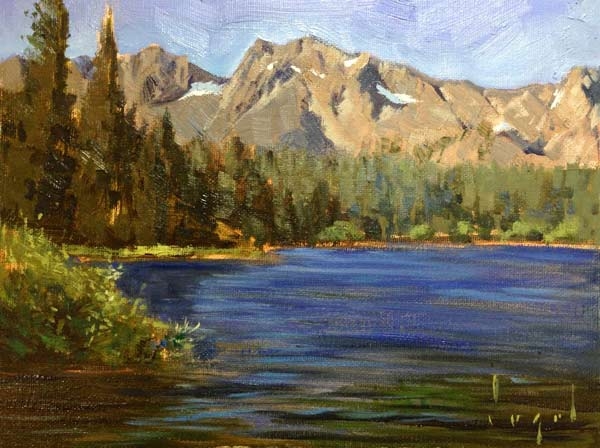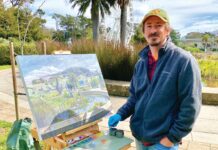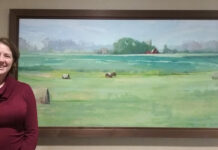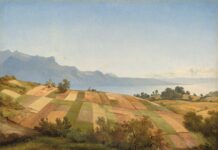Robert Vogel left the Eastern Sierras to live in Los Angeles. But those mountains are still his favorite place to paint. Why?
“You almost can’t miss,” says Vogel. “Every place you look is a painting. I go about every three months.”

“God’s Country,” by Robert Vogel, oil, 9 x 12 in.
It’s a six-hour drive to the area he likes in the Eastern Sierras, the land around Mammoth Mountain. “The west side of the Sierras is gentle, more rolling,” he says. “The east side is very rugged. Desolate but beautiful.”

“Lundy Canyon,” by Robert Vogel, oil
Vogel likes the jagged cliffs and the lakes in the high country on the east side. He ventures 10,000 feet up in some places, “where the air is rarefied,” he says. “There’s very little in the way of atmospheric perspective. The light is strong and clear.”

“Silver Lake and Carson Peak,” by Robert Vogel, oil, 16 x 20 in. Studio
The artist is a big fan of the warm light of early morning and late afternoon, and he paints no larger than 9″-x-12″ for the most part so he can concentrate on getting that light down before it changes. “A variety of elements are changing, starting with the sky,” he points out. “The temperature of the light is changing, too, from warm to cool. It’s a race to try and catch a snapshot.”

“Mammoth Mountain From the Meadow,” by Robert Vogel, oil, 8 x 10 in.
Vogel doesn’t dig deep into the geology or flora of the area. “Knowledge is power, so the more you know, that’s good,” says the artist. “But as painters, if you can paint the feeling of light on the form, that may be the most important thing.”

“Mojave Desert Sunrise,” by Robert Vogel, oil, 18 x 24 in. Studio
The painter says his most important mentor is Jason Situ, and his biggest preoccupation is getting the value and temperature relationships correct in a painting. “I like to paint plein air pieces and then blow them up larger if they are good — a 3″-x-4″ plein air study can become the basis of an 18″-x024″ studio piece,” says Vogel. “With the plein air piece, you have hopefully captured the true colors and true relationships between the elements, including the size relationships of areas and objects.”

“Mammoth Mtn. Morning,” by Robert Vogel, oil, 9 x 12 in.
He acknowledges the struggles he goes through with values and temperatures, and the compelling painting “Lundy Canyon” shows evidence of his adjustments. The dead tree in the composition adds interest and a design element to the scene, but the top of it is not depicted in this earlier version of the piece. It was painted, but then painted over when Vogel felt that he had to adjust the value and temperature of the mountains behind it. “It’s not uncommon for me to have to adjust things,” he says cheerfully. A later version of the painting has the dead tree’s top restored.

All of the plein air paintings from Vogel’s last trip to the Eastern Sierras. They range in size from 9″ x 12″ down to 3″ x 4″.
Lundy Canyon is a favorite spot for the L.A. painter. It’s not surprising considering Vogel’s affinity for mountains and water. “It’s just out of this world,” says Vogel. “I mean, it’s hard to believe it’s real.”





Excellent “words of wisdom” – We can always learn and that comes from an artist who just celebrated his 80th. Keep on painting and teaching! Albert
point #6: Are you SERIOUS? with the greatest respect, sir, what the HELL does that even MEAN?
point #6: Are you SERIOUS? with the greatest respect, sir, what the HELL does that even MEAN?
Susiehyer, read a book on the Greek gods and it will become clear to you.
It is perfect time to make some plans for the future and it is time
to be happy. I have read this post and if I could I want to suggest you few interesting things or tips.
Maybe you can write next articles referring to this article.
I desire to read even more things about it!